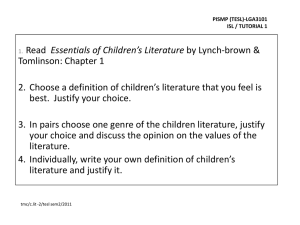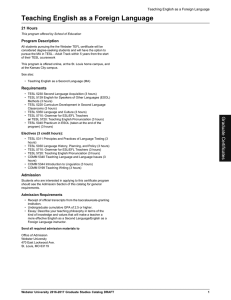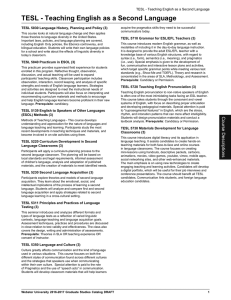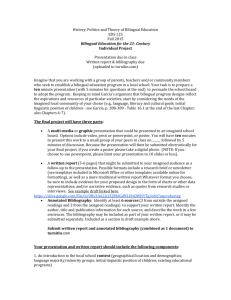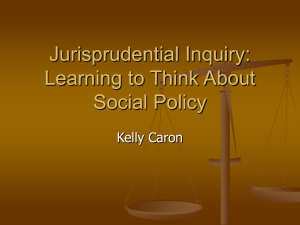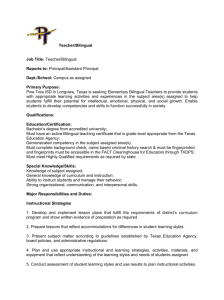Autonomy, Technology, and Language
advertisement
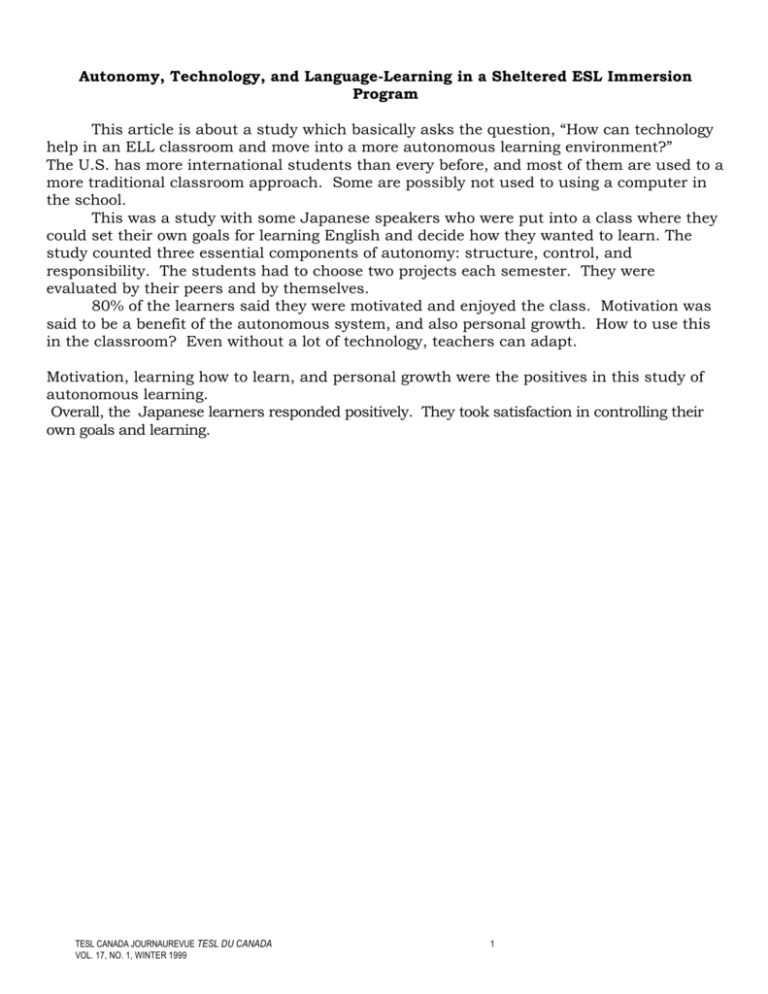
Autonomy, Technology, and Language-Learning in a Sheltered ESL Immersion Program This article is about a study which basically asks the question, “How can technology help in an ELL classroom and move into a more autonomous learning environment?” The U.S. has more international students than every before, and most of them are used to a more traditional classroom approach. Some are possibly not used to using a computer in the school. This was a study with some Japanese speakers who were put into a class where they could set their own goals for learning English and decide how they wanted to learn. The study counted three essential components of autonomy: structure, control, and responsibility. The students had to choose two projects each semester. They were evaluated by their peers and by themselves. 80% of the learners said they were motivated and enjoyed the class. Motivation was said to be a benefit of the autonomous system, and also personal growth. How to use this in the classroom? Even without a lot of technology, teachers can adapt. Motivation, learning how to learn, and personal growth were the positives in this study of autonomous learning. Overall, the Japanese learners responded positively. They took satisfaction in controlling their own goals and learning. TESL CANADA JOURNAUREVUE TESL DU CANADA VOL. 17, NO. 1, WINTER 1999 1 Language Teaching Research This article is about Content Based Language Teaching (CBLT). It is a summary of 5 studies of different language learning classes and what role the teachers played in the CBLT and the need for training for the instructors to be able to meet these goals. There was a wide range of learners within the 5 groups: Chinese, Spanish, Malaysian. These were immersion programs, language driven and augmented the straight language study with additional classes in the “foreign”language, such as literature, nature, science, geography, and math. This was supposed to broaden their knowledge and make the lessons more interesting. Other countries have used this method for many years. Some countries have used it to teach regional languages such as Gaelic in Scotland. At least half the curricumlum is sometimes in the given language. English is the main target language in many of the countries that use this method; examples are Japan and Hong Kong. This is a summary of 5 Instructional settings: A 2 way Spanish English school in US Thre nature and society lessons taught in English in China English math and science taught in two Malaysian high schools CLIL classes in Spain at two high schools where history is taught in English Sheltered instructions for ELL in U.S. schools For the most part, these programs were not terribly successful because the teachers were not prepared and not instructed properly. One teacher program has been helpful, however. The SIOP model for professional development (Sheltered Instruction Observation Protocol) has been successful. Teachers played the most important role in these classes by: *The influence they have on students’ expectations *Their ability to structure lessons and fuse language and content *Collaboratives tasks to create reciprocal learning *Guidance *Learner-centered and inquiry-based instructions that engage students TESL CANADA JOURNAUREVUE TESL DU CANADA VOL. 17, NO. 1, WINTER 1999 2 A JUDICIAL AND LEGISLATIVE PERSPECTIVE OF BRINGUAL EDUCATION The U.S. has had an increase in the number of non-English speakers. Approximately 80% of these students come from Spanish speaking homes, mainly in Florida, Texas, California, and New York previously. But now also concentrations of these students in Georgia, Oregon, Washington, and NC. The best way to teach these kids has been debated for years. In the 19th century, there were bilingual programs because of the various immigrant populations. In the Mid-West—German, French in Louisiana and Spanish in the SW area of the United States. Germans were very interested in preserving their culture and language. During the 20th century, the bilingual education movement can be divided into 3 periods: The Assimilation period 1900 to 1960; The Re-birth period 1960 to 1994; and the Reactionary Period, 1994 to the present. Due to WWI, growing sentiments of English only. Anti-German sentiment shut down the German programs in the Mid-West. In a notable case—Meyer v NE, a teacher was accused of tutoring a child in German. The United States Supreme Court said that the state could not prohibit teaching foreign languages, however the state can dictate that teaching must be in English only. This case marked the end of bi-lingual education as they knew it in the 19th century, when the teachers were native language speakers. From 1917 to 1969, many states had English only laws. This changed somewhat beginning in the mid to late 1960’s. Space race and Cuban missile crisis, people thought they ought to start learning other languages. Lyndon Johnson, who was called the education president had been a teacher and signed the Bilingual Education Law legitimizing the use of a student’s native language as a tool to help them in school. Lat v. Nichols(1974) was the most significant and pivotal case impacting bilingual education legislation. In 1974, the United Sates Supreme Court ruled in a 9-0 decision that school districts must take necessary steps to ensure that non-English-speaking students have an equal educational opportunity. In 1996, California voted to eliminate bilingual education. Non-English speaking children had to enroll in English immersion classes. Bilingual education was by parents request only. As we look back to Plessy v Ferguson, a case in 1896, the Supreme Court said separate is not equal in schools. We are color blind, with no caste system, no class system. But in the area of languages students are treated differently. TESL CANADA JOURNAUREVUE TESL DU CANADA VOL. 17, NO. 1, WINTER 1999 3 The Bilingual Education Act of 1968, is the main law still in place that governs bilingual Education. It has been pretty much cut back or not increased over the years. There has been little interest in bilingual education; mostly because there has not been enough money to fund the programs we need. Educators have grave concerns about this situation. The focus is not to foster a second language, but rather to get everyone to speak English as quickly as possible. It is a worry that perhaps soon, all schools with ELL’s will be in the “needs improvement” category. TESL CANADA JOURNAUREVUE TESL DU CANADA VOL. 17, NO. 1, WINTER 1999 4




